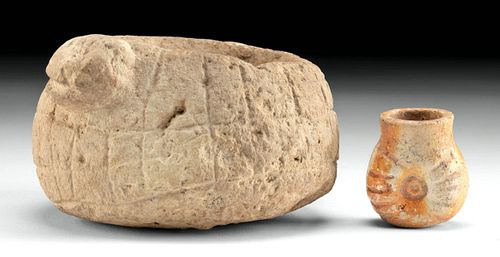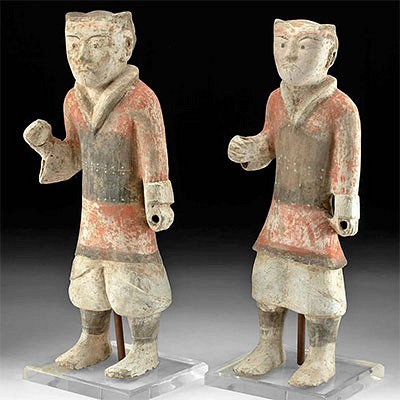Maya Poison Jar + Zoomorphic Mortar, ex-Schmitt
Lot 97c
About Seller
Artemis Fine Arts
686 S Taylor Ave, Ste 106
Louisville, CO 80027
United States
Selling antiquities, ancient and ethnographic art online since 1993, Artemis Gallery specializes in Classical Antiquities (Egyptian, Greek, Roman, Near Eastern), Asian, Pre-Columbian, African / Tribal / Oceanographic art. Our extensive inventory includes pottery, stone, metal, wood, glass and textil...Read more
Categories
Estimate:
$600 - $900
Absentee vs Live bid
Two ways to bid:
- Leave a max absentee bid and the platform will bid on your behalf up to your maximum bid during the live auction.
- Bid live during the auction and your bids will be submitted real-time to the auctioneer.
Bid Increments
| Price | Bid Increment |
|---|---|
| $0 | $25 |
| $300 | $50 |
| $1,000 | $100 |
| $2,000 | $250 |
| $5,000 | $500 |
| $10,000 | $1,000 |
| $20,000 | $2,500 |
| $50,000 | $5,000 |
| $100,000 | $10,000 |
| $200,000 | $20,000 |
About Auction
By Artemis Fine Arts
May 25, 2023
Set Reminder
2023-05-25 10:00:00
2023-05-25 10:00:00
America/New_York
Bidsquare
Bidsquare : ON-SALE! Antiquities, Pre-Columbian, Ethno, Fine Art
https://www.bidsquare.com/auctions/artemis-gallery/on-sale-antiquities-pre-columbian-ethno-fine-art-12860
ON-SALE Antiquities, Pre-Columbian, Ethno, More! Artemis Fine Arts info@artemisfinearts.com
ON-SALE Antiquities, Pre-Columbian, Ethno, More! Artemis Fine Arts info@artemisfinearts.com
- Lot Description
Pre-Columbian, Southern Mexico to Guatemala, Maya, Late Classic Period, ca. 550 to 900 CE. A pair of ancient Maya pieces - a stone mortar carved into a zoomorphic creature, and a petite pottery vessel known as a "poison jar." The volcanic stone has a protruding knob like head with incised eyes and mouth, and a tail on the opposite side. The rounded walls are etched with lines that create a cross hatched surface like the scales of a snake. The basin is very shallow and may have been used for grinding, the animal perhaps imbuing power to the substance used in ritual ingestion or other religious activities. Size: 4.5" L x 3.5" W x 2.25" H (11.4 cm x 8.9 cm x 5.7 cm)
Traditionally, the petite jarlet vessels were known as "poison" or "medicine" bottles, in part because of their comparison to similar vessels used by other cultures, but further analysis suggests they may have had other uses. They are often found in the context of burials, filled with red pigment like cinnabar or hematite, but with the remains of other things underneath the pigment (as if they were used in life and then filled with pigment upon death). Their size indicates they held dear substances not required in large quantities such as poisons or medicines, but also perfume, tobacco, and ritual drugs like powdered mushrooms.
Provenance: ex-Marc Amiguet Schmitt estate, Amiguet's Ancient Art, Evansville, Indiana, USA; (small jar) purchased February 11, 2020 from Arte Xibalba, Osprey, Florida, USA; ex- Sonia Toledo collection, Miami, Florida, USA, acquired via descent from Adolfo Martinez
All items legal to buy/sell under U.S. Statute covering cultural patrimony Code 2600, CHAPTER 14, and are guaranteed to be as described or your money back.
A Certificate of Authenticity will accompany all winning bids.
We ship worldwide and handle all shipping in-house for your convenience.
#174986Chips and abrasions to pottery jar, otherwise intact. Light mineral and earthen deposits on surfaces and interior. Chips and abrasions to stone mortar. Light earthen deposits on the surface.Condition
- Shipping Info
-
All shipping is handled in-house for your convenience. Your invoice from Artemis Gallery will include shipping calculation instructions. If in doubt, please inquire BEFORE bidding for estimated shipping costs for individual items.
-
- Buyer's Premium



 EUR
EUR CAD
CAD AUD
AUD GBP
GBP MXN
MXN HKD
HKD CNY
CNY MYR
MYR SEK
SEK SGD
SGD CHF
CHF THB
THB














